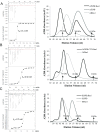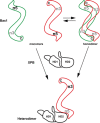Structural basis of the XPB-Bax1 complex as a dynamic helicase-nuclease machinery for DNA repair
- PMID: 32374860
- PMCID: PMC7293015
- DOI: 10.1093/nar/gkaa324
Structural basis of the XPB-Bax1 complex as a dynamic helicase-nuclease machinery for DNA repair
Abstract
Nucleotide excision repair (NER) is a major DNA repair pathway for a variety of DNA lesions. XPB plays a key role in DNA opening at damage sites and coordinating damage incision by nucleases. XPB is conserved from archaea to human. In archaea, XPB is associated with a nuclease Bax1. Here we report crystal structures of XPB in complex with Bax1 from Archaeoglobus fulgidus (Af) and Sulfolobus tokodaii (St). These structures reveal for the first time four domains in Bax1, which interacts with XPB mainly through its N-terminal domain. A Cas2-like domain likely helps to position Bax1 at the forked DNA allowing the nuclease domain to incise one arm of the fork. Bax1 exists in monomer or homodimer but forms a heterodimer exclusively with XPB. StBax1 keeps StXPB in a closed conformation and stimulates ATP hydrolysis by XPB while AfBax1 maintains AfXPB in the open conformation and reduces its ATPase activity. Bax1 contains two distinguished nuclease active sites to presumably incise DNA damage. Our results demonstrate that protein-protein interactions regulate the activities of XPB ATPase and Bax1 nuclease. These structures provide a platform to understand the XPB-nuclease interactions important for the coordination of DNA unwinding and damage incision in eukaryotic NER.
© The Author(s) 2020. Published by Oxford University Press on behalf of Nucleic Acids Research.
Figures








Similar articles
-
Structural basis of the XPB helicase-Bax1 nuclease complex interacting with the repair bubble DNA.Nucleic Acids Res. 2020 Nov 18;48(20):11695-11705. doi: 10.1093/nar/gkaa801. Nucleic Acids Res. 2020. PMID: 32986831 Free PMC article.
-
The XBP-Bax1 helicase-nuclease complex unwinds and cleaves DNA: implications for eukaryal and archaeal nucleotide excision repair.J Biol Chem. 2010 Apr 2;285(14):11013-22. doi: 10.1074/jbc.M109.094763. Epub 2010 Feb 6. J Biol Chem. 2010. PMID: 20139443 Free PMC article.
-
Conserved XPB core structure and motifs for DNA unwinding: implications for pathway selection of transcription or excision repair.Mol Cell. 2006 Apr 7;22(1):27-37. doi: 10.1016/j.molcel.2006.02.017. Mol Cell. 2006. PMID: 16600867
-
The nucleotide excision repair protein UvrB, a helicase-like enzyme with a catch.Mutat Res. 2000 Aug 30;460(3-4):277-300. doi: 10.1016/s0921-8777(00)00032-x. Mutat Res. 2000. PMID: 10946234 Review.
-
XPB: An unconventional SF2 DNA helicase.Prog Biophys Mol Biol. 2015 Mar;117(2-3):174-181. doi: 10.1016/j.pbiomolbio.2014.12.005. Epub 2015 Jan 30. Prog Biophys Mol Biol. 2015. PMID: 25641424 Review.
Cited by
-
Phenotypic Characterization and Whole-Genome Analysis of a Novel Bacteriophage HCF1 Infecting Citrobacter amalonaticus and C. freundii.Front Microbiol. 2021 Jan 25;12:644013. doi: 10.3389/fmicb.2021.644013. eCollection 2021. Front Microbiol. 2021. PMID: 33569047 Free PMC article.
-
Structural basis of the XPB helicase-Bax1 nuclease complex interacting with the repair bubble DNA.Nucleic Acids Res. 2020 Nov 18;48(20):11695-11705. doi: 10.1093/nar/gkaa801. Nucleic Acids Res. 2020. PMID: 32986831 Free PMC article.
-
Molecular wrench activity of DNA helicases: Keys to modulation of rapid kinetics in DNA repair.Protein Sci. 2023 Dec;32(12):e4815. doi: 10.1002/pro.4815. Protein Sci. 2023. PMID: 37874269 Free PMC article.
-
Isolation, phenotypic characterization and comparative genomic analysis of 2019SD1, a polyvalent enterobacteria phage.Sci Rep. 2021 Nov 12;11(1):22197. doi: 10.1038/s41598-021-01419-8. Sci Rep. 2021. PMID: 34772986 Free PMC article.
References
-
- Fan L., Arvai A.S., Cooper P.K., Iwai S., Hanaoka F., Tainer J.A.. Conserved XPB core structure and motifs for DNA unwinding: implications for pathway selection of transcription or excision repair. Mol. Cell. 2006; 22:27–37. - PubMed
-
- Ma X., Hong Y., Han W., Sheng D., Ni J., Hou G., Shen Y.. Single-stranded DNA binding activity of XPBI, but not XPBII, from Sulfolobus tokodaii causes double-stranded DNA melting. Extremophiles. 2011; 15:67–76. - PubMed
-
- Gulyas K.D., Donahue T.F.. SSL2, a suppressor of a stem-loop mutation in the HIS4 leader encodes the yeast homolog of human ERCC-3. Cell. 1992; 69:1031–1042. - PubMed
-
- Koken M.H., Vreeken C., Bol S.A., Cheng N.C., Jaspers-Dekker I., Hoeijmakers J.H., Eeken J.C., Weeda G., Pastink A.. Cloning and characterization of the Drosophila homolog of the xeroderma pigmentosum complementation-group B correcting gene, ERCC3. Nucleic Acids Res. 1992; 20:5541–5548. - PMC - PubMed

